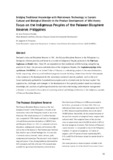Revisiting the Ligawasan marshland in Mindanao: An indigenous resource management system study towards sustainability
| dc.contributor.author | Sinolinding, Harris M. | |
| dc.contributor.author | Porciuncula, Fe L. | |
| dc.contributor.editor | Cuvin-Aralar, Maria Lourdes | |
| dc.contributor.editor | Punongbayan, Raymundo S. | |
| dc.contributor.editor | Santos-Borja, Adelina | |
| dc.contributor.editor | Castillo, Lourdes V. | |
| dc.contributor.editor | Manalili, Eduardo V. | |
| dc.contributor.editor | Mendoza, Marlynn M. | |
| dc.date.accessioned | 2021-07-27T07:57:51Z | |
| dc.date.available | 2021-07-27T07:57:51Z | |
| dc.date.issued | 2005 | |
| dc.identifier.citation | Sinolinding, H. M., & Porciuncula, F. L. (2005). Revisiting the Ligawasan marshland in Mindanao: An indigenous resource management system study towards sustainability. In M. L. Cuvin-Aralar, R. S. Punongbayan, A. Santos-Borja, L. V. Castillo, E. V. Manalili, & M. M. Mendoza (Eds.), Proceedings of the First National Congress on Philippine Lakes (pp. 214-229). Southeast Asian Regional Center for Graduate Study and Research in Agriculture (SEARCA). | en |
| dc.identifier.issn | 1656-8099 | |
| dc.identifier.uri | http://hdl.handle.net/10862/6139 | |
| dc.description.abstract | The Ligawasan Marshland covering an area of 288,000 ha is important to hundreds of thousands of Magindanawan Bangsamoro fisher-farmers whose basic means of livelihood are wild fishing and traditional rice farming. This study evaluates the indigenous resource management system and indigenous laws in fishing and rice farming and the effects to the sustainability of the marshland. Most of the fisher-farmers practiced traditional fishing and farming beliefs/rituals which promoted sustainability since giving respect to the marshland as a sacred place deters overexploitation. In terms of indigenous laws, bans on electric and chemical fishing, and fry catching are strictly enforced. A peaceful coexistence is preserved among the heads of barangays, traditional religious leaders, and the Bangsamoro mujahideen leaders to enable them to work in unity amidst some diversity. An exclusive open access and rights to control only among Magindanawan Bangsamoro is observed which show their control over accessibility and utilization of the marshland. Aquatic wildlife remains abundant in the marshland to include species of fish, crustaceans, mollusks, and other aquatic organisms with economic value. Values obtained on the physico-chemical properties [dissolved oxygen (DO) - 4.67 g/L; pH - 6.99; water turbidity - 53.30 cm; dissolved solids (DS) - 136.04 mg/L) of the marshland were within the normal range indicating that the area remains an ideal habitat for fish and other aquatic resources. The overall sustainability level (using ecological soundness, cultural acceptability, social justice, economic viability and technological appropriateness dimensions) of the marshland was rated moderate with a mean rating of 75.06. This indicates that the marshland has gained some degree of degradation due to the occurrence of natural calamities and centuries of utilization of the area by the fishers-farmers. Based on the findings, a sustainability framework is put forward to strike a balance between the socioeconomic and biophysical environment, and the indigenous resource management system and laws to enhance sustainability of the Ligawasan Marshland. | en |
| dc.language.iso | en | en |
| dc.publisher | Southeast Asian Regional Center for Graduate Study and Research in Agriculture (SEARCA) | en |
| dc.subject | Indigenous resource management system | en |
| dc.subject | Indigenous laws | en |
| dc.subject | rice | en |
| dc.subject | cultivation | en |
| dc.subject | seed germination | en |
| dc.subject | planting | en |
| dc.subject | weeding | en |
| dc.subject | hand weeding | en |
| dc.subject | threshing | en |
| dc.subject | solar drying | en |
| dc.title | Revisiting the Ligawasan marshland in Mindanao: An indigenous resource management system study towards sustainability | en |
| dc.type | Conference paper | en |
| dc.citation.spage | 214 | en |
| dc.citation.epage | 229 | en |
| dc.citation.conferenceTitle | Proceedings of the First National Congress on Philippine Lakes | en |
| dc.subject.asfa | sustainability | en |
| dc.subject.asfa | socioeconomic aspects | en |
| dc.subject.asfa | pest control | en |
| dc.subject.asfa | harvesting | en |
| dc.subject.asfa | fishing | en |
| dc.subject.asfa | fishing gear | en |
| dc.subject.asfa | marketing | en |
| dc.subject.asfa | fertilization | en |
| dc.subject.asfa | pricing | en |
| dc.subject.asfa | economics | en |
| dc.subject.asfa | processing | en |
Files in this item
| Files | ขนาด | รูป | View |
|---|---|---|---|
|
There are no files associated with this item. |
|||
รายการนี้ปรากฏใน (s)
-
LakeCon2003 [49]
Proceedings of the First National Congress on Philippine Lakes




